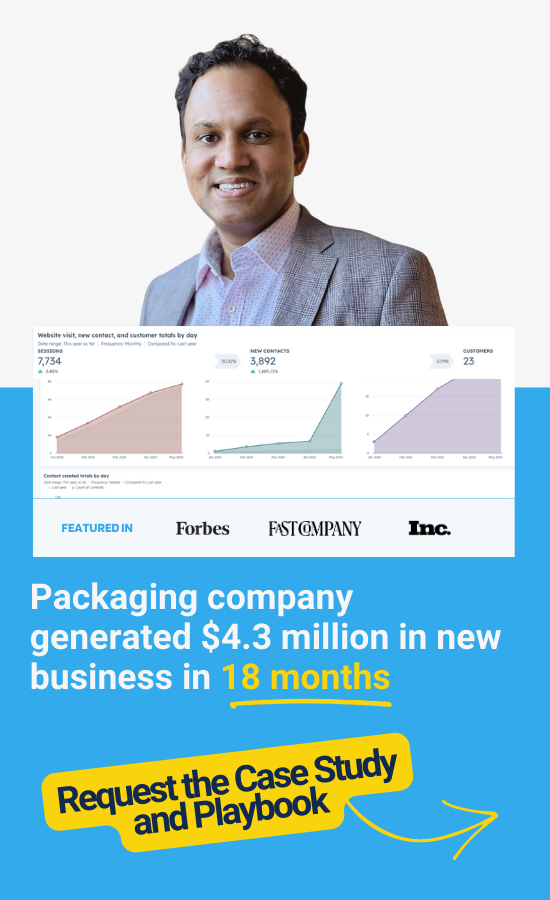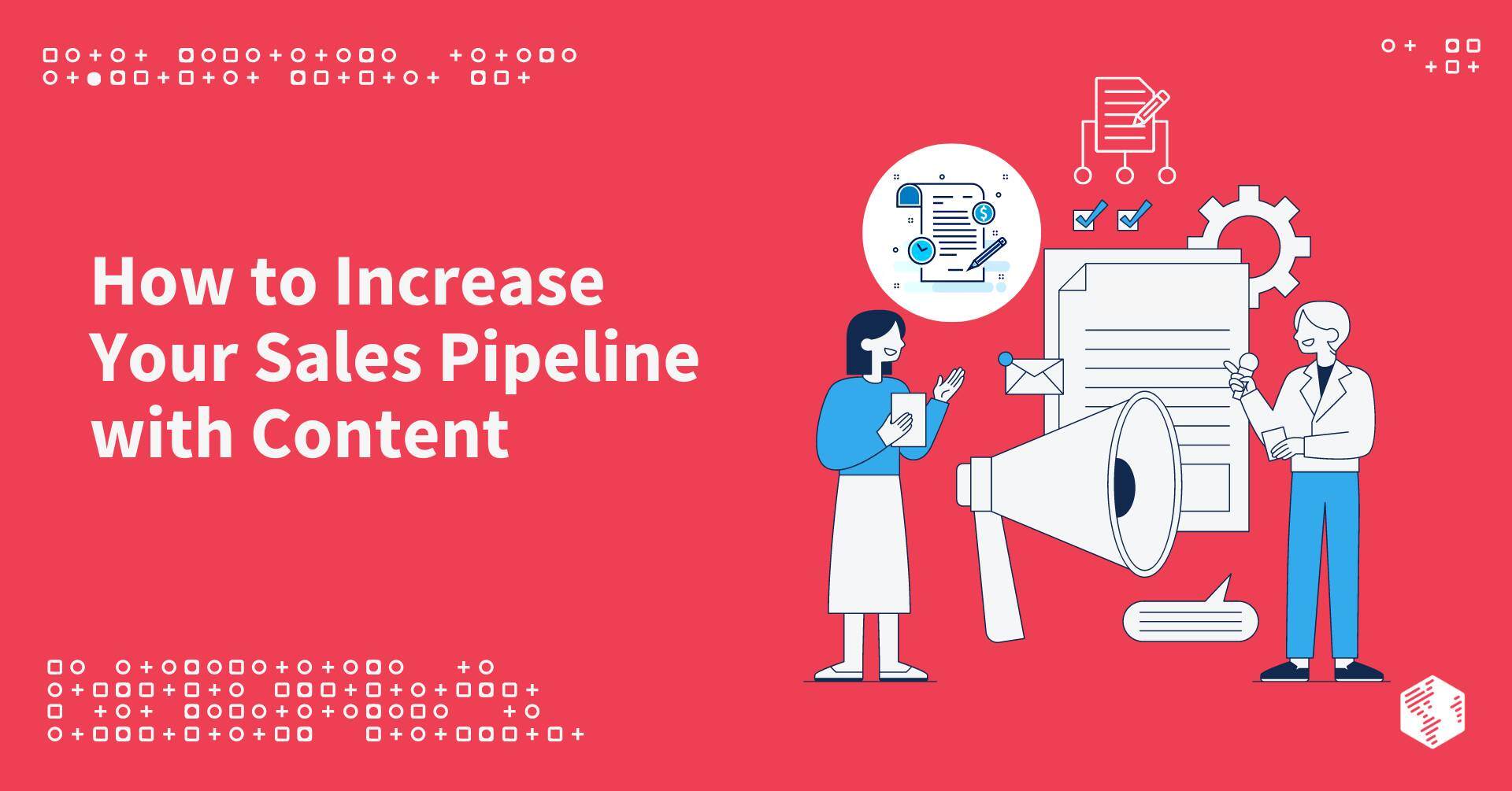Successful B2B businesses—those that are meeting their revenue goals and growing year after year—tend to have one thing in common: a healthy, growing sales pipeline.
An effective, robust pipeline is essential to revenue growth, carrying a business through ups and downs and leading to consistent, sustainable sales. But increasing your pipeline is more than just getting leads. Strategic pipeline management requires you to turn data into valuable insights and establish sustainable business practices that generate a stable flow of highly qualified leads.

How do you increase your pipeline? Taking a look at today’s B2B landscape, where 96% of prospects do their own research before reaching out to a human sales representative, it’s clear that content marketing continues to be a powerful way to drive pipeline growth.
Content Marketing for Business Growth: The Power of Content in Increasing the Sales Pipeline
We know content marketing is an important part of B2B growth. According to the Content Marketing Institute, B2B marketers say that content marketing has helped generate leads (76%) and more sales (58%). But how, exactly, does content marketing contribute to sales pipelines?
As B2B buyers research solutions to their problems, they turn to search engines, company websites, social media, emails, videos, and case studies to get the information they need to evaluate their options before contacting a business directly. Finding the right content at the right moment, then, captures their attention and interest. When leads come across this valuable, interesting, helpful content, they engage more deeply and then move through the pipeline, progressing through each stage of the buyer’s journey until they are ready to make a purchase.
It’s that online content that is key to attracting and engaging your buyers, nurturing leads, and converting them into paying customers.
That’s why publishing consistent, high-quality content—from blog posts and videos to social posts and newsletters—is key to increasing your sales pipeline.
How to Use Content Marketing to Grow Your Business: 12 Tips for B2B Companies

Content marketing provides a range of benefits for B2B companies, including increasing visibility on search engines, establishing brand authority on a topic, and building trust with ideal buyers, while also serving as the foundation for sustainable pipeline growth. Follow these tips to make sure your content marketing strategy supports your pipeline goals.
1. Define Your Target Audience
Each part of every content asset—from landing pages to calls-to-action (CTAs)—should be curated to target your ideal buyers, and you can only do so if you truly know them.
Start by getting a crystal-clear understanding of your target audience. Defining detailed buyer personas, negative buyer personas, and ideal customer profiles (ICPs) makes it easy to create content that resonates with your audience, qualify prospects more accurately, and hone your messaging to close deals fast.
2. Create a Go-To Content Library
A strong pipeline strategy requires a range of content assets. As buyers do their homework, research and compare options, and look for solutions to their pain points, they turn to online content for answers. Your job is to be their go-to source of information.
Build a library of go-to content resources your marketing and sales teams can share with prospects to help move them through the sales pipeline. Having valuable, helpful content available at the snap of the finger will make it easier than ever for your team to address buyer concerns as well as shorten the overall sales cycle.
It’s important to have both evergreen content and topical content. While evergreen content always remains relevant to the interests of your audience, topic content is timely and helps keep your organization at the top of mind (and search engines).
3. Stay Organized & Consistent with a Content Calendar
When it comes to successful content marketing and sustainable pipeline growth, consistency is key. By scheduling and planning out your content ahead of time, you can make sure your team stays on track, your content stays fresh and relevant, and your business website stays visible on search engines.
Use a content calendar to stay organized. These living documents detail everything to know about content deadlines—including the creation, publication, distribution, and promotion of content—so you and your team maintain a consistent schedule.
4. Optimize Your Website for Conversions
As buyers do their own research, engage with your content, and move along the pipeline, they will eventually end up at your website—your business’s home base on the internet. Why not make sure your website is primed to convert them into paying customers?
Optimize your website for conversions so prospects don’t hit any stumbling blocks on their path to purchase. Keep your message clear, create a mobile-friendly website, use strong visuals, maintain a simple but clear navigation system, offer lead magnets throughout, and implement best search engine optimization (SEO) practices to increase your online visibility and make it easier for qualified prospects to find your website.
Then, when potential customers are looking for a solution to their problem, it will be easier for them to find and explore your products and services.
5. Use a Strong Call-to-Action (CTA)
Content may be the backbone of a robust sales pipeline, but it won’t be effective unless you use each piece of content to move your audience forward along the buyer’s journey. CTAs are an effective way to provide prospects with the next step, whether downloading a lead magnet, signing up for a webinar, or scheduling a free consultation.
To create strong CTAs, use clear, concise language, create attractive visuals, highlight positives, and maintain a sense of urgency. You can also use CTAs—and how prospects respond to them—to further segment your audience and track the performance content pieces.
6. Offer Different Ways for Prospects to Contact You
Let’s set the stage: A potential buyer has engaged with your content, explored their options, and decided they want to learn more about your products or services.
Now what?
If they can’t easily get in touch with you—and get a quick response in return—then all your work creating, publishing, and distributing the content that got them here was for naught.
Make sure your business’s contact information is available (and easy to find) on all content pieces, and provide several contact options like a phone number, email address, and live chat. And don’t forget to create a system to promptly respond to inquiries from potential customers so your hard work doesn’t go to waste.
7. Make It Easy for Prospects to Learn About Your Products or Services
Look at a similar scenario: A lead has learned more about their problem and is ready to find a product or solution to address it. After some self-driven research, they have come across your company and want to learn more about your offerings.
This is a critical point in the pipeline—and if it’s not easy for prospects to get information about your products or services, they will have no choice but to turn to your B2B competitors.
Your job is to make it easy for leads to explore your offerings. Create comprehensive product or service pages, publish a list of frequently asked questions (FAQs) and their answers, offer information in multiple formats, use clear language, and build an effective search function directly into your website. These actions will simplify the process for buyers and encourage them to learn more about your products or services (since, after all, it’s so easy to do so).
8. Map Content to Every Stage of the Buyer’s Journey
Leads require different types of content as they move through the sales pipeline. By mapping content assets to every stage of the buyer’s journey, you can ensure your marketing team and sales representatives have exactly the content they need to engage with buyers at the right time.
For example, during the awareness stage, you should provide content like blog posts, infographics, guides, and explainer videos that help buyers understand their initial problem. Later, during the consideration stage, buyers are researching solutions to their problem, so they need technical, specific educational content like whitepapers and webinars that set your company (and offering) apart from the competition. Then, when buyers are ready to make a purchase, share customer testimonials and product comparisons that show them exactly why your B2B organization is the best choice.
By creating content that aligns with each stage of the buyer’s journey, you will create content that resonates with buyers throughout the entire purchasing process.
9. Collaborate with Industry Leaders & Influencers
Who are the leaders in your industry? Who do your buyers trust? Influencer marketing is an effective way to create content that excites and intrigues buyers as well as build trust and authority with your audience.
Find the industry influencers your audience engages with and work with them one-on-one to create new content. From podcast interviews and videos to guest writing and curated recommendations, the power of influencer marketing knows no bounds—and leads to the kind of content that supports a healthy, growing sales pipeline.
10. Produce Different Types of Content
People like different things and learn in different ways. It’s true in the B2B world, too.
Create different types of content to reach various segments of your target audience. There is a wide variety of content formats to choose from, including text (blog posts, ebooks, whitepapers, social posts, etc.), video (webinars, product videos, testimonials, etc.), and audio (podcasts, audio books, interviews, etc.). Make sure you are casting a wide net so you will be more likely to catch the right fish.
11. Repurpose Existing Content Assets
There’s no “one and done” when it comes to a successful content marketing strategy. Why spend the time and resources to create one content piece when you can transform that piece into many different content assets, leading to an increased return on investment (ROI)?
Content repurposing—changing larger/longer content pieces into multiple assets, repurposing several smaller content pieces into a major asset, or simply sharing published content in new formats—requires creativity and planning. But this innovative, resourceful approach to content marketing allows you to reach new audiences in new ways, bringing in more qualified leads to your sales pipeline.
12. Back Up Content with Current Data
If you want your content to help increase your sales pipeline, buyers have to be able to trust the things you say. If your audience doesn’t trust you, they won’t engage further with your content or move along the stages of your buyer’s journey.
You can establish this trust through accurate content that is backed up by facts, data, and statistics. When you consistently create well-researched, authoritative, trustworthy content, your buyers know they can trust you and will consider you a leader in the industry. And when you establish that trust, they will be more likely to engage with your content, follow your CTAs, learn more about your products or services, and convert into a paying customer.
Conclusion
Content marketing is a powerful strategy for increasing your sales pipeline. By creating engaging, valuable content that appeals to your target audience, you can attract qualified leads, build trust and credibility, and drive more sales.
And if you’re looking for a content market partner, we can help. At OneIMS, we specialize in helping B2B companies attract new audiences, retain existing customers, and generate more revenue through spectacular content (and more). Schedule a consultation with us today to learn more about how OneIMS can help your business achieve your growth goals.






